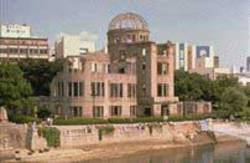Menu

Hiroshima, Nagasaki: never again!
August 2017: In Japan and around the world, the 72nd anniversary of the first use of atomic power against human beings will be remembered.
Hiroshima on August 6th - a city, a symbol, and a call to end the atomic age.
On the morning of August 6th, 1945, an unusual new kind of weapon was dropped on the city of Hiroshima. Three days later a second atomic bomb was dropped on Nagasaki.
..."In Hiroshima, a millisecond after 8.16 a.m., on 6th August 1945, the temperature at the core of the hundreds of feet wide fireball reached 50,000,000 degrees. Flesh burned two miles distant from it’s outer parameters.
80,000 people were killed or mortally injured instantly. The main area targeted was “the city’s principal residential, commercial and military quarters.”
The entrance to the Shima Clinic was flanked by great stone columns – “They were rammed straight down in to the ground.” The building was destroyed: “The occupants were vapourised.”
-- Excerpt from Hiroshima – A Criminal Enterprise From Which Nothing Has Been Learned by Felicity Arbuthnot, Global Research, August 03, 2017
See our report: Women and the Bomb
Mayors for Peace:
The Mayors for Peace is composed of cities around the world that have formally expressed support for the program Mayor Araki announced in 1982. As of August 1, 2017, membership stood at 7,417 cities in 162 countries and regions.
See a map showing the cities that have signed on.
The Japan Council against Atomic and Hydrogen Bombs (Gensuikyo) was established in September 1955. Since then it has waged various kinds of campaigns for: the prevention of nuclear war; the total ban on and the elimination of nuclear weapons; and support and solidarity with Hibakusha (victims of the atomic bombing.)
The debate on why the bomb was used:
The myths of Hiroshima
By Kai Bird and Martin J. Sherwin,
(coauthors of "American Prometheus: The Triumph and Tragedy of J. Robert Oppenheimer")
..."The bomb was dropped, as J. Robert Oppenheimer, scientific director of the Manhattan Project, said in November 1945, on 'an essentially defeated enemy.' President Truman and his closest advisor, Secretary of State James Byrnes, quite plainly used it primarily to prevent the Soviets from sharing in the occupation of Japan. And they used it on Aug. 6 even though they had agreed among themselves as they returned home from the Potsdam Conference on Aug. 3 that the Japanese were looking for peace..."
Patriotic Correctness: the Hiroshima cover-up
"In the weeks following the atomic attacks on Japan sixty-six years ago this week, and then for decades afterward, the United States engaged in airtight suppression of all film shot in Hiroshima and Nagasaki after the bombings. This included vivid color footage shot by U.S. military crews and black-and-white Japanese newsreel film."...
Daniel Ellsberg: Hiroshima Day: America Has Been Asleep at the Wheel for 64 Years August 6, 2009
A moving and thought-provoking essay on the connections between Hiroshima and his own life.
Brecht and the responsibility of the scientist
WLOE e.V. member Constanze Frank spoke at the Upaya Zen Center in Santa Fe, NM. before the showing of "Fat Man and Little Boy", a film about the Manhattan Project.
Hiroshima: Was it necessary?
This site has many links and sources for more information.



